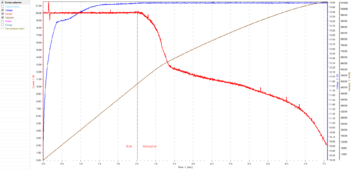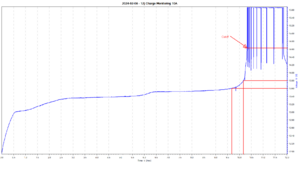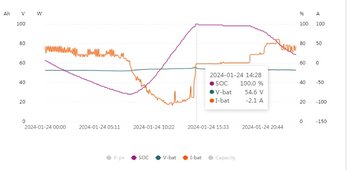sunshine_eggo
Happy Breffast!
Thought I'd try a little something on a cheap 12V I've been testing...
Charge to 20A @ 13.6V (3.4V/cell), 2A tail current.
When testing at cell level and dealing with testers that don't have separate sense leads, lead resistance plays a big role, and I would typically observe cells get charged to about 95% SoC @ 3.4V.
Here's a plot of the charge:

0.2C charge
2.5 hour bulk
5 hour absorption
0.02C tail current
104.6Ah input (tested at 105.5Ah)
Have about a 0.12V drop in the leads @ 30A, so it's pretty negligible at 2A.
With sense leads, it would have spent more time in bulk, but not a lot.
Subsequent charges:
3.45V/cell, 0.1C with 0.01C tail current: 0.5Ah input
3.50V/cell, 0.05C with 0.005C tail current: 0.2Ah input
Very little added, and one could argue the low tail currents at these voltage levels indicate full charge or even slight overcharge.
No way to monitor individual cells.
For comparison, this was the voltage log of a 10A charge to 15.6V (was counting on BMS cut-off):

This was done with a 30V/10A supply. I didn't want to risk my charger reacting badly to BMS cut-off when I know the power supply can take it. With only a few brief exceptions the power supply output 10A the whole time, so the time scale is equivalent to time * 10Ah capacity and represents a 0.1C charge and tail current.
At 9.7 hours, 13.6V, 97Ah input.
At 10.2 hours, 13.8V, 102Ah input.
etc.
The last 1.5 hours was the BMS coming out of protection and briefly charging again before re-engaging protection.
Charge to 20A @ 13.6V (3.4V/cell), 2A tail current.
When testing at cell level and dealing with testers that don't have separate sense leads, lead resistance plays a big role, and I would typically observe cells get charged to about 95% SoC @ 3.4V.
Here's a plot of the charge:

0.2C charge
2.5 hour bulk
5 hour absorption
0.02C tail current
104.6Ah input (tested at 105.5Ah)
Have about a 0.12V drop in the leads @ 30A, so it's pretty negligible at 2A.
With sense leads, it would have spent more time in bulk, but not a lot.
Subsequent charges:
3.45V/cell, 0.1C with 0.01C tail current: 0.5Ah input
3.50V/cell, 0.05C with 0.005C tail current: 0.2Ah input
Very little added, and one could argue the low tail currents at these voltage levels indicate full charge or even slight overcharge.
No way to monitor individual cells.
For comparison, this was the voltage log of a 10A charge to 15.6V (was counting on BMS cut-off):

This was done with a 30V/10A supply. I didn't want to risk my charger reacting badly to BMS cut-off when I know the power supply can take it. With only a few brief exceptions the power supply output 10A the whole time, so the time scale is equivalent to time * 10Ah capacity and represents a 0.1C charge and tail current.
At 9.7 hours, 13.6V, 97Ah input.
At 10.2 hours, 13.8V, 102Ah input.
etc.
The last 1.5 hours was the BMS coming out of protection and briefly charging again before re-engaging protection.



